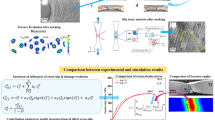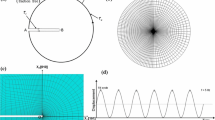Abstract
The tension necking of FCC copper single crystal specimen with a square cross section was analyzed under the slip deformation mechanism. The actual clamp manner of the specimen was modeled by setting correlative boundary condition, and the small angle deflection between tension loading axis and crystallography axis [100] was taken into account. The finite deformation numerical analysis of three-dimensional necking deformation for the specimen was performed by applying crystal plasticity theory associated with a numerical algorithm suggested by the first author. According to the comparison with experimental observation, the fact was confirmed that the numerical results could describe the loading elongation curve of the copper single crystal specimen under large strain tension reasonably, and the method could be used to investigate the necking characteristic in neck shape and the effect due to the small angle deflection. Further, the investigation into the influence of specimen cross-section shape on necking was also performed; the results on mechanical response and neck profile evolution obtained through modeling of cylindrical specimen were compared with those obtained with square cross-section specimen.
Similar content being viewed by others
References
Hill R, Rice J R. Constitutive analysis of elastic-plastic crystal at arbitrary strain. J Mech Phys Solids, 1972, 20: 401–13
Asaro R J, Rice J R. Strain localization in ductile single crystals. J Mech Phys Solids, 1977, 25: 309–338
Peirce D, Asaro R J, Needleman A. Material rate dependence and localized deformation in crystalline solids. Acta Metall, 1983, 31: 1951–1976
Kalidindi S R, Bronkhorst C A, Anand L. Crystallographic texture evolution in bulk deformation processing of FCC metals. J Mech Phys Solids, 1992, 40: 537–569
Maniatty A M, Dawson P R, Lee Y S. A time integration algorithm for elasto-viscoplastic cubic crystals applied to modeling polycrystalline deformation. Inter J Num Meth Engrg, 1992, 35: 1565–1588
Sarma G, Zacharia G. Integration algorithm for modeling the elastoviscoplastic response of polycrystalline materials. J Mech Phys Solids, 1999, 47: 1219–1238
Asaro R J, Needleman A. Texture development and strain hardening in rate dependent polycrystals. Acta Metall, 1985, 33: 923–953
Needleman A, Asaro R J, Lemonds J, et al. Finite element analysis of crystalline solids. Comp Methods Appl Mech Eng, 1985, 52: 689–708
Watanabe O, Zbib H M, Takenouchi E. Crystal plasticity: micro-shear banding in polycrystals using Voronoi tessellation. Int J Plas, 1998, 14: 771–788
Kuroda M, Tvergaard V. Shear band development predicted by a non-normality theory of plasticity and comparison to crystal plasticity predictions. Int J Solids Struct, 2001, 38: 8945–8960
Hutchinson J W. Elastic-plastic behavior of polycrystalline metals and composites. Phil Proc R Soc London, 1970, A318: 247–272
Zhang K S. Microscopic heterogeneity and macroscopic mechanical behavior of a polycrystalline material. Acta Sin Mech (in Chinese), 2004, 36: 714–723
Hutchinson J W. Bounds and self-consistent estimates for creep of polycrystalline materials. Proc Roy Soc Lond, 1976, 348A: 101–127
Peirce D, Shih C F, Needleman A. A tangent modulus method for rate dependent solids. Comput Struct, 1984, 18: 875–887
Zhang K S. A finite element algorithm for frystal viscoplastic finite deformation. Mech Sci Tech (in Chinese), 2001, 20(suppl.): 1–4
Xu Z M, Li L, Li J G, et al. Orientation and competitive growth of single crystal copper by continuous casing. J Synth Cryst (in Chinese), 1999, 28: 188–192
Hirth J P, Lothe J. Theory of Dislocations. 2nd ed. New York: John Wiley and Sons, 1982
Author information
Authors and Affiliations
Corresponding author
Additional information
Supported by the National Natural Science Foundation of China (Grant Nos. 10472092 and 10662001) and the Aviation Science Foundation of China (Grant No. 04C53027)
Rights and permissions
About this article
Cite this article
Zhang, K., Geng, X., Li, J. et al. On the tension necking of copper single crystal specimen under slip deformation mechanism. SCI CHINA SER E 50, 308–318 (2007). https://doi.org/10.1007/s11431-007-0038-9
Received:
Accepted:
Issue Date:
DOI: https://doi.org/10.1007/s11431-007-0038-9




